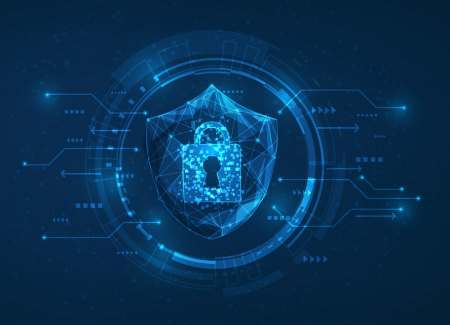Top 5 Components of the TCP/IP Model: A Guide for Cybersecurity Pros

In our interconnected world, the Transmission Control Protocol/Internet Protocol Model (TCP/IP Model) has undeniably become a pivotal element for grasping the nuances of network communication. For cybersecurity professionals, this isn’t merely a luxury; it’s an essential tool. As we delve deeper into this topic, we’ll soon uncover the reasons why this model stands as a foundational pillar in the vast realm of digital communication. Now, you might wonder, what is TCP model? And, importantly, why does it hold such a commanding position in cybersecurity? Let’s find out why.
In this blog, you will learn:
- What is the TCP/IP Model, and Why is it Important in Cybersecurity?
- How Does the TCP/IP Model Differ From the OSI Model?
- What are the Key Components and Layers of the TCP/IP Model?
- How Do TCP and IP Protocols Work Together Within the TCP/IP Model?
- How Does a Deep Understanding of the TCP/IP Model Enhance Network Security Measures?
- Frequently Asked Questions About the TCP/IP Model
 What is the TCP/IP Model, and Why is It Important in Cybersecurity?
What is the TCP/IP Model, and Why is It Important in Cybersecurity?
The TCP/IP model is more than just a technical term. It is a comprehensive framework meticulously designed to ensure efficient and error-free data transmission over various communication channels. As we witness the relentless expansion of the digital universe, the demand for secure and efficient data transmission escalates accordingly. And this is where the TCP/IP model becomes indispensable. Furthermore, for those in the cybersecurity field, especially network administrators and IT professionals, understanding what is TCP model isn’t just beneficial—it’s essential. Consequently, it serves as the bedrock upon which various network applications are built and executed during data transmission.
ALSO READ: What is Threat Modelling: Definition, Process and Methodologies
Cybersecurity Courses
How Does the TCP/IP Model Differ From the OSI Model?
1. Origins and Development
The TCP/IP model was birthed during the intense Cold War era. Its primary aim was to connect computers across vast national boundaries for the U.S. Department of Defense. In contrast, the Open Systems Interconnection (OSI) model was conceptualized to demystify the complex communication processes during data transmission.
2. Layer Composition
A closer look reveals that the OSI model is structured with seven distinct layers. However, the TCP/IP model is more concise, encompassing just four TCP IP Model layers.
3. Functionality and Application
While the OSI model predominantly serves as a theoretical guide, the TCP/IP model is where theory meets practice. It’s actively implemented in real-world scenarios, especially within computer networks.
4. Layer Responsibilities
In the OSI model, the session and presentation layers are individual entities. Furthermore, in the TCP/IP model, they converge, thus finding their niche within the application layer.
5. Usage and Popularity
In terms of popularity and widespread use, the TCP/IP model reigns supreme. As a matter of fact, it’s the most widely adopted protocol suite today, especially on the internet. Meanwhile, the OSI model, though less prevalent, holds its ground as a valuable reference point.
ALSO READ: Top Cybersecurity Trends to Keep Your Businesses Safe in 2023
What are the Key Components and Layers of the TCP/IP Model?
1. Application Layer
The top layer of the TCP/IP model seamlessly interfaces with user applications, ensuring software applications understand the presented data. Moreover, it skillfully manages data representation, making sure the information is correctly formatted for transmission. As it channels this data to the transport layer, it employs protocols such as HTTP, SMTP, and FTP, which are operational here, thus facilitating various internet functions.
2. Transport Layer
Acting as a crucial bridge in the TCP/IP model, the transport layer forges connections between devices. Not only does it establish these connections, but it also diligently segments data into packets. Moreover, it ensures their error-free transmission, guaranteeing that the data reaches its intended destination intact. Within this layer, protocols like TCP and User Datagram Protocol (UDP) are at play, each serving its unique purpose in data transmission.
3. Internet Layer
The internet layer is pivotal in orchestrating data transmission across various network modes. It is crucial in the assignment of IP addresses to ensure that data packets are directed to the correct destination. Protocols like IP and ARP are instrumental here. They work in tandem to route data packets and resolve IP addresses to physical addresses, respectively.
4. Network Access Layer
A fusion of the data-link and physical layer, this layer serves as the foundation of the TCP/IP model. Furthermore, it oversees the transmission of raw binary data across physical communication channels. This ensures that the data is ready for transmission over the network. Hence, this layer is responsible for the physical connection between devices, managing aspects like voltage levels and data rates.
5. Interplay of Layers
As data embarks through the TCP IP Model layers, it adheres to a well-defined pattern for efficient and seamless transmission. Consequently, each layer interacts with the one above and below it, passing data in a structured manner. In fact, this systematic flow transmits data efficiently, securely, and without errors from source to destination.
ALSO READ: 7 Worst Types of Cyberattacks and Threats in 2023 (Solutions Included)
How Do TCP and IP Protocols Work Together Within the TCP/IP Model?
1. TCP’s Role
At its very core, TCP stands as the unwavering guardian of reliable and orderly data transfer. In essence, it seamlessly employs a diverse range of mechanisms. These include—but aren’t limited to—sequence numbers, acknowledgments, and timeouts. As a result, each of these mechanisms ensures that data transmission is both consistent and error-free.
2. IP’s Function
IP acts as the navigator in this vast digital sea. Specifically, it routes data packets from one host to another. And while it consistently strives for perfection, it’s essential to note that it doesn’t always guarantee delivery. Needless to say, such is the nature of the vast and unpredictable world of digital communication.
3. Interdependence
TCP and IP are undeniably vital cogs in the network communication machinery. Yet, they serve distinct and unique roles. TCP acts as the diligent custodian of data transfer, ensuring every bit is in its rightful place. IP emerges as the strategic mastermind behind routing, ensuring data finds its way through the vast digital labyrinth.
4. Protocols in Play
Beyond just TCP and IP, the digital realm is teeming with a myriad of other protocols. Interestingly, each of them plays a pivotal role in ensuring smooth communication. In fact, protocols such as ICMP, ARP, FTP, and SMTP seamlessly integrate within the TCP/IP suite. Each of these protocols contributes to the larger picture of efficient digital communication.
5. Importance of TCP/IP
At the heart of it all, the TCP IP Model in computer network offers more than just a structure. It, evidently, provides an architectural blueprint—a map if you will—that facilitates instantaneous communication across a diverse range of network media. This blueprint transforms the once-distant dream of global internet communication into a tangible, everyday reality.
ALSO READ: Top 10 Cyber Security Jobs in India
How Does a Deep Understanding of the TCP/IP Model Enhance Network Security Measures?
1. Foundation of Cybersecurity
A profound understanding of the TCP IP model in computer networks serves as a bedrock for cybersecurity initiatives. Therefore, by delving deep into its intricacies, professionals can equip themselves with the tools and insights to preempt potential vulnerabilities. Consequently, they can also help tackle these threats head-on, ensuring a robust defense mechanism from the outset.
2. Network Monitoring
Transitioning to the realm of network surveillance, the TCP/IP model acts as a guiding compass. With this model as a foundational reference, monitoring network traffic evolves from a daunting task to a more streamlined process. As a result, professionals can swiftly detect anomalies, thus fortifying defenses and mitigating potential breaches before they escalate.
3. Protocol Analysis
Moving forward, the art of protocol analysis becomes pivotal. Hence, by meticulously analyzing the protocols nestled within the TCP/IP suite, professionals don’t just skim the surface. They delve deeper, unearthing irregularities and potential threats that might otherwise lurk in the shadows. As a matter of fact, this proactive approach identifies and addresses potential vulnerabilities promptly.
4. Enhanced Defense Mechanisms
With the wealth of knowledge derived from the TCP/IP model, the creation of defense mechanisms takes a strategic turn. Professionals aren’t just reacting to threats; they’re anticipating them. Armed with this foresight, they can design and implement formidable firewalls, state-of-the-art intrusion detection systems, and other robust defense mechanisms. This proactive stance ensures that networks remain impervious to a myriad of threats.
5. Strategic Planning
A holistic understanding of the TCP/IP model isn’t just about knowledge — it’s all about practical application. Therefore, with this comprehensive grasp, cybersecurity professionals don’t just formulate strategies haphazardly. Instead, they craft them with precision, tailoring them to address specific vulnerabilities and executing them with finesse. This ensures that every strategy is not only effective but also efficient in safeguarding digital assets.
ALSO READ: Understanding Vulnerability in Cybersecurity: How to Keep Your Data Safe
 Frequently Asked Questions
Frequently Asked Questions
1. What is a Good Understanding of TCP IP?
The TCP/IP model entails a thorough understanding of its layers, protocols, and the intricate dance they perform. This ensures efficient and secure data transmission.
2. What is the Best Way to Remember the TCP IP Model?
Leveraging mnemonics, visual aids, and hands-on applications can significantly bolster memory retention.
3. What is the TCP IP Model’s Easy Explanation?
It represents a meticulously crafted framework designed to ensure efficient and error-free transmission of data across diverse communication channels.
4. What is the Best Book on TCP IP?
The literary realm offers a plethora of authoritative books on this subject, each catering to varying depths of understanding. The ‘TCP/IP Illustrated’ by Kevin R. Fall and W. Richard Stevens is one of the best books on TCP/IP.
ALSO READ: Here’s How to Build an Accelerating Career in Cybersecurity
In conclusion, as we navigate the vast expanse of cybersecurity, the TCP/IP model emerges as a beacon, guiding professionals in their quest for secure and efficient data transmission. Moreover, as we’ve explored, its layers, protocols, and functionalities are pivotal in the digital communication landscape. For those keen on diving deeper into this subject and elevating their cybersecurity expertise, consider checking out this cybersecurity course by the world’s best universities on Emeritus to take a step in the right direction of your journey in the cybersecurity field.
Write to us at content@emeritus.org






